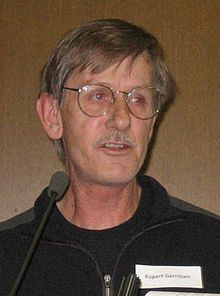Name Rupert Gerritsen | Role Author | |
 | ||
Books And Their Ghosts May be Heard | ||
Rupert Gerritsen (1953–2013) was an Australian historian and a noted authority on Indigenous Australian prehistory. Coupled with his work on early Australian cartography, he played an influential part in re-charting Australian history prior to its settlement by the British in 1788. He died in Canberra, A.C.T. on Sunday 3 November 2013.
Contents
- Early years
- Indigenous Prehistory and Early Australian Historical Research
- Other Research
- Awards
- Australia on the Map
- Current Research
- Selected publications
- References
Early years
Rupert Gerritsen was born in Geraldton, Western Australia in 1953, of Dutch parents. He grew up in Geraldton where he experienced first hand the excitement of the discovery of the wreck of the Batavia in 1963 and came to know some of those involved in its discovery and the discovery of other 17th and 18th century shipwrecks on the coast of Western Australia.
From 1960s through to the 1980s he was involved in radical politics and social activism and promoted social justice and empowerment.
Professionally he was engaged for many years in Western Australia and the ACT in youth work, community work and mental health, and specialise in developmental work.
Indigenous Prehistory and Early Australian Historical Research
Although not his first work published, And Their Ghosts May Be Heard, (1994, 2nd edition in 2002), is perhaps the best known. It is a detailed exploration of the fate of the Dutch mariners castaway on the Western Australian coast in the 1600s and early 1700s.
Gerritsen was involved in establishing that possibly some 16% of Nhanda, an Aboriginal language of the central west coast of Western Australia, was derived from Dutch as a result of interaction with marooned sailors. This groundbreaking discovery has led to major reevaluation in the perceptions of the early prehistory in that Aboriginal Australians were not mute witnesses to the unfolding events history but active participants who embraced parts of European culture long before the British settlement of the continent.
On a more specific level, Gerritsen also researched the location where two mutineers from the Batavia mutiny, possibly Australia’s first European settlers, were marooned on 16 November 1629. As a consequence of his research Gerritsen established that Hutt River, 500 kilometres north of Perth, was the site where Wouter Loos and Jan Pelgrom de Bye first set foot on mainland Australia. These discoveries wrought a complete change in the methodology of recording early Western Australian pre-history. Many subsequent scholars have embraced this new historical paradigm in their works. The result is the ending of triumphal history which described the inevitability of growth of wealth and prosperity of Western Australia under the shroud of British colonialism. Such a view suppressed the inclusiveness of other voices which, through the march of time, proved to be an anathema to a multicultural society.
After the appearance of Ghosts, Gerritsen published a range of papers and monographs in diverse fields, from archaeology to historical linguistics, and another book, Australia and the Origins of Agriculture. This work put forward evidence that some Indigenous groups in Australia in traditional circumstances were engaged in food production, including agriculture, and lived in large permanent settlements.
Other Research
Gerritsen undertook research and published extensively on a diverse range of subjects. This included:
Awards
In recognition of his work on Australian pre-history and its Dutch influence, in 2007, Queen Beatrice of the Netherlands conferred upon Gerritsen the honour of Knight of the Order of Orange-Nassau.
In August 2012 Gerritsen was awarded the Dorthy Prescott Prize for the paper, "Getting the strait facts straight", he gave at the Brisbane International Geospatial Forum.
Australia on the Map
Gerritsen was co-founder, along with Peter Reynders, of Australia on the Map: 1606–2006, and was that organisation’s National Secretary. At his death he was Chair of its successor organisation, the Australia on the Map Division of the Australasian Hydrographic Society which aims to make Australians more aware of Australia's early history and heritage, beginning in 1606.
Under the Australia on the Map Division of the Australasian Hydrographic Society, Gerritsen had sole or joint responsibility for a number of projects, including the "Search for the Deadwater Wreck".
Current Research
Gerritsen was a Petherick Researcher at the National Library of Australia since April 1995. and focussed his research and writing on early Australian history.
